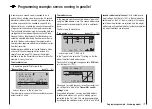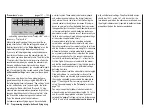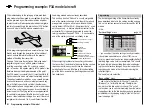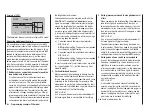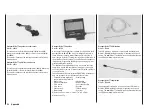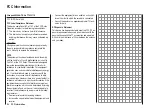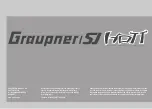
186
Programming example: model helicopter
Programming example: model helicopter
In this programming example we assume that you
have already read and understood the descriptions of
the individual menus, and are by now familiar with the
general handling of the transmitter. We also assume that
you have assembled and adjusted the helicopter exactly
according to the kit instructions. The electronic facilities
provided by the transmitter should never be used to
compensate for major mechanical inaccuracies.
As so often in life, there are various ways and means of
reaching a particular destination when programming the
mx-16
HoTT. In this example our intention is to provide
a sensibly structured course of action, so that you have
a clear idea of logical programming techniques. Where
there are several possible methods, we first describe the
simplest and most easily understood solution. It is likely
that the helicopter will work perfectly when set up in this
way, but naturally you are still free to try out other solu-
tions at a later stage, in case they suit you better.
As our programming example we take the
Graupner
STARLET 50 helicopter, with right-hand rotation, three
swashplate linkage points distributed evenly at 120°
(“3Sv (2 roll)” type), a beginner’s set-up without en-
hanced throttle curve, without heading-lock gyro system,
no method of influencing the gyro’s “normal operating
mode” from the transmitter, and with no speed governor
(regulator).
We have deliberately chosen this simple programming
project in order to demonstrate that it is possible to set
up a helicopter which flies extremely well with relatively
little programming effort.
Nevertheless, we do not want to forfeit all the possible
refinement facilities: after the basic description you will
also find set-up notes on gyro gain, speed governors
and flight phase programming.
Note:
If, in contrast to the glow-powered machine described
here, your main interest lies in electric-powered model
helicopters, then please read on! Apart from the idle
adjustments, which naturally do not apply, you can adopt
most of the settings described in the following section
virtually unchanged.
To initiate this typical programming exercise move to the
“
Model memory
” menu, then to the …
“select model”
sub-menu
… where you select a free model memory using the
arrow buttons of the left or right-hand touch-key:
03
04
05
free
02
01
06
R08
free
free
free
free
After touching the central
SET
button of the right-hand
touch-key, you can use the
button of the left or right-
hand touch-key to select …
Sel model type
( empty mod mem )
… the “Helicopter” model type. Confirm your choice by
touching the central
SET
button of the right-hand touch-
key, and the screen immediately switches to the basic
display.
Notes:
Once you have called up the “Model select” option it
•
is not possible to interrupt the process, i. e. you must
choose one or other model type. Even if you switch
the transmitter off, then on again, you still have to
make this choice. However, if you make a mistake
you can always correct it simply by erasing the mod-
el memory.
If the warning message “Throttle too high” appears,
•
you can erase it by turning the rotary proportional
knob CTRL 6 anti-clockwise to its end-point.
If the battery voltage is too low, you will not be able
•
to change model memories for safety reasons. In this
case the screen displays an appropriate message:
not possible now
voltage too low
Once you have overcome this initial hurdle, it is essential
to bind the receiver installed in the model to this model
memory in the …
Summary of Contents for mx-12 Hott
Page 1: ...Programming Manual 33116 mx 16 HoTT 3 en mx 16...
Page 35: ...35 For your notes...
Page 49: ...49 For your notes...
Page 55: ...55 For your notes...
Page 59: ...59 For your notes...
Page 63: ...63 For your notes...
Page 69: ...69 For your notes...
Page 91: ...91 For your notes...
Page 101: ...101 For your notes...
Page 123: ...123 For your notes...
Page 181: ...181 For your notes...
Page 193: ...193 For your notes...






